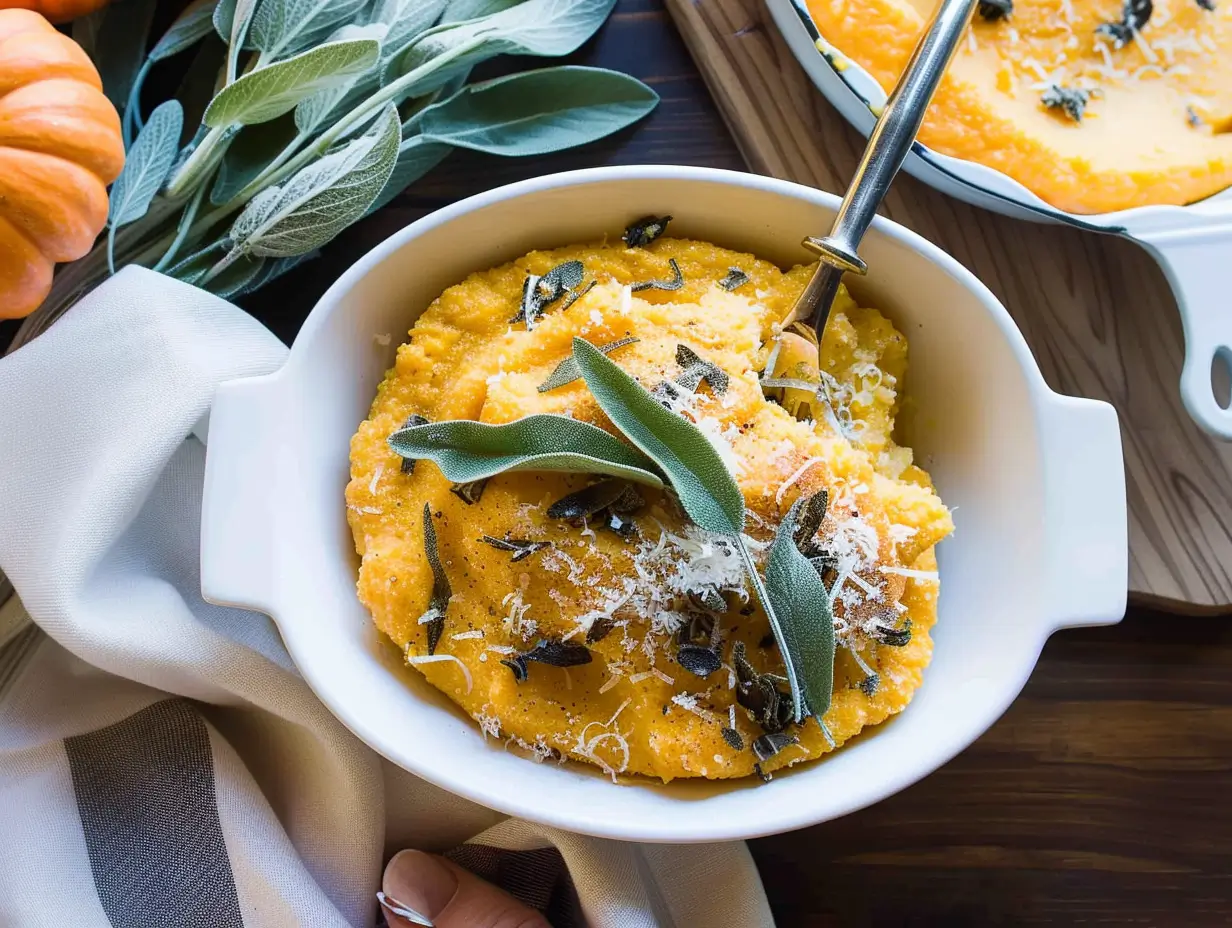As the weather cools down, there’s nothing quite like a warm, hearty dish to bring comfort and satisfaction to your table. This Creamy Pumpkin Polenta with Fresh Sage and Parmesan is the perfect autumn dish that combines the earthy sweetness of pumpkin with the savory richness of sage and Parmesan. With its creamy texture and robust flavors, this dish is perfect as a cozy side or even a standalone meal. It’s also versatile, fitting for vegetarian diets and easily adaptable with a few simple tweaks.
Let’s break down the steps to creating this wholesome and flavorful dish!
Ingredients:
- 2 cups whole milk
- 1 cup chicken or vegetable broth (use vegetable broth for a vegetarian option)
- 1 cup polenta (coarse cornmeal)
- 1 cup pumpkin purée (canned or homemade)
- 2 tablespoons unsalted butter
- 2 tablespoons fresh sage, finely chopped
- 1/2 cup grated Parmesan cheese
- Salt and pepper to taste
- Optional garnishes: extra Parmesan and fresh sage
Directions:
Step 1: Heat the Liquid
In a medium saucepan, combine the whole milk and broth over medium heat. Bring the mixture to a simmer, stirring occasionally to prevent it from scalding.
Step 2: Whisk in the Polenta
Once the milk and broth are gently simmering, slowly whisk in the polenta. Make sure to add it gradually, constantly whisking, to prevent lumps from forming.
After the polenta is incorporated, reduce the heat to low. Stir the mixture frequently, allowing it to cook for 25-30 minutes. The polenta should become smooth and creamy as it absorbs the liquid. If it thickens too much before fully cooking, you can add more broth or milk, a little at a time, to maintain the desired consistency.
Step 3: Add Pumpkin, Butter, and Sage
Once the polenta is smooth and cooked, stir in the pumpkin purée. The addition of pumpkin brings a delightful autumnal sweetness and boosts the creaminess of the dish.
Next, add the unsalted butter and finely chopped fresh sage, and cook for an additional 5 minutes. This allows the butter to melt and the sage to infuse its earthy, aromatic flavor into the polenta.
Step 4: Fold in Parmesan and Season
Remove the saucepan from the heat and fold in the grated Parmesan cheese. The Parmesan adds a savory, nutty richness that complements the pumpkin and sage perfectly.
Taste the polenta and season it with salt and pepper to your liking. The amount of salt may vary depending on how salty your broth and Parmesan are, so be sure to adjust accordingly.
Step 5: Serve and Garnish
Serve the pumpkin sage polenta hot. For a finishing touch, you can garnish the dish with extra grated Parmesan and a sprinkle of fresh sage for added flavor and visual appeal.
Serving and Storage Tips:
- Serving Suggestions: This creamy pumpkin polenta pairs beautifully with roasted vegetables, grilled chicken, or sautéed mushrooms. It can also be enjoyed on its own as a satisfying vegetarian entrée.
- Storage: Store any leftovers in an airtight container in the refrigerator for up to 3 days. To reheat, add a splash of milk or broth and warm it up on the stovetop or in the microwave, stirring occasionally to restore its creamy texture.
- Freezing: You can freeze pumpkin polenta by letting it cool completely, then transferring it to a freezer-safe container. It will keep well in the freezer for up to 2 months. When reheating from frozen, thaw it in the refrigerator overnight and reheat with some additional liquid.
Helpful Notes:
- Consistency: Polenta can firm up as it cools. If you prefer a looser, creamier consistency, you can stir in more milk or broth just before serving.
- Pumpkin Purée: If using canned pumpkin purée, ensure it’s plain pumpkin, not pumpkin pie filling, which contains added sugars and spices. Homemade pumpkin purée also works beautifully in this recipe and adds a fresh flavor.
- Sage: Fresh sage gives this dish a vibrant herbal note, but if you don’t have fresh sage on hand, you can use dried sage (about 1 teaspoon). However, fresh is always best for the most aromatic results.
Tips from Well-Known Chefs:
- Giada De Laurentiis recommends using a combination of milk and broth to cook the polenta. The milk adds richness, while the broth deepens the savory flavors.
- Alice Waters suggests stirring the polenta frequently during cooking to achieve the smoothest texture. This prevents clumping and ensures even cooking.
- Michael Symon advises finishing the polenta with a generous amount of Parmesan cheese to add a sharp, salty contrast to the creamy, mellow pumpkin.
Frequently Asked Questions (FAQs):
1. Can I make this recipe vegan?
Yes! Substitute the milk with almond milk or any other plant-based milk, and replace the butter with a vegan butter alternative. For the Parmesan, you can either use nutritional yeast or a vegan Parmesan substitute.
2. Can I use instant polenta?
Yes, you can use instant polenta to reduce the cooking time. Follow the instructions on the packaging for the best results, and then proceed with the recipe by adding the pumpkin, butter, sage, and Parmesan.
3. Can I make this recipe ahead of time?
Yes, pumpkin polenta can be made ahead and reheated. The polenta will firm up as it cools, so you may need to stir in additional milk or broth when reheating to regain its creamy consistency.
4. What can I use instead of Parmesan?
If you don’t have Parmesan on hand, Pecorino Romano or Grana Padano are excellent substitutes. For a non-dairy alternative, try nutritional yeast.
5. Can I use water instead of broth?
Yes, you can substitute the broth with water, but keep in mind that using broth adds a depth of flavor that plain water won’t provide. Vegetable or chicken broth gives the dish more savory complexity.
6. Is this recipe gluten-free?
Yes! Polenta is naturally gluten-free, making this dish a great option for those avoiding gluten. Just ensure your broth and other ingredients are gluten-free if needed.
7. How do I prevent lumps in my polenta?
The key to lump-free polenta is adding the cornmeal slowly while whisking continuously. This ensures the grains are evenly dispersed and absorb the liquid properly.
8. Can I use fresh pumpkin instead of canned?
Absolutely! To make your own pumpkin purée, roast or steam the pumpkin until tender, then blend or mash it until smooth. Make sure to drain excess water to avoid a runny purée.
9. What can I serve with this pumpkin sage polenta?
This dish pairs wonderfully with roasted chicken, grilled sausages, or even a hearty stew. For a vegetarian option, serve it with sautéed mushrooms or roasted seasonal vegetables.
10. Can I use dried sage instead of fresh?
Yes, but use dried sage sparingly, as it’s more concentrated in flavor. About 1 teaspoon of dried sage should suffice in place of the fresh sage.
This Creamy Pumpkin Sage Polenta is the ultimate autumn comfort food. With its rich, smooth texture and a blend of savory and sweet flavors, it’s a versatile dish that will quickly become a seasonal favorite. Whether you’re serving it as a side or a main course, this dish offers a comforting and delicious way to enjoy the flavors of fall!





